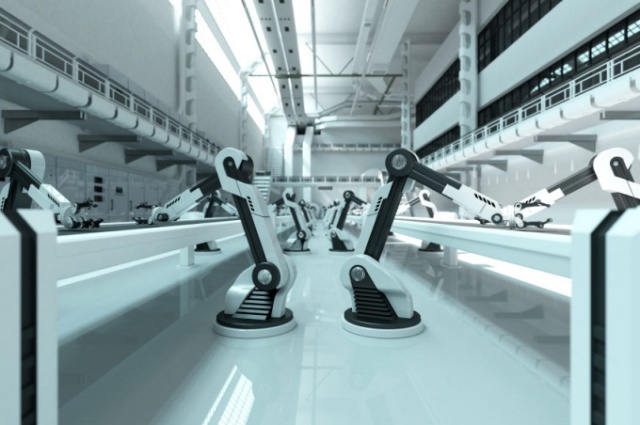Aug 1 2014
Will every household soon have a 3-D printer? How does origami lead to safer airbags and other innovations? Will robots do more than vacuum your home?
These questions and much more will be deliberated as roughly 2,000 engineers gather Aug. 17-20 in the Buffalo Niagara Convention Center in downtown Buffalo to discuss advanced manufacturing and design at the ASME 2014 International Design and Engineering Technical Conferences & Computers and Information in Engineering Conference.
 Robotic manufacturing
Robotic manufacturing
Organized by the American Society of Mechanical Engineers (ASME) and hosted by UB, the conference will include executives from Fortune 500 companies, scholars, entrepreneurs, students and others working in robotics, computer-aided engineering, 3-D printing and other emerging technologies.
“This conference will bring together people, from our own backyard and across the world, who are developing solutions to the most pressing problems that we as a society face. They’re building safer automobiles. They’re creating smarter medical devices. They’re making our factories more efficient,” says Liesl Folks, dean of the UB School of Engineering and Applied Sciences.
Among the topics and notable speakers:
Here come the robots
Technological advancements plus investment (Google alone bought eight robotics startups last year) is pushing robots from niche industries into everyday life.
Sunil Agrawal, a mechanical engineering professor at Columbia University, will discuss how robotics is emerging as a tool for training human skills and functional movement. Agrawal will speak during a session from 10:30 a.m. to 12:10 p.m. Aug. 19.
Redefining American manufacturing
If manufacturing is to continue its comeback in the U.S., it will need to be even more nimble, adaptable and intelligent.
Helmuth Ludwig, chief executive officer of Siemens Industry Sector for the United States, will share how the multinational engineering and electronics conglomerate is helping lead the resurgence of U.S. manufacturing. He will speak at 11:20 a.m. Aug. 18.
Origami-based engineering design
The traditional art of paper folding began centuries ago in Japan, but it’s now a driving force of engineering design. Scientists use the math behind origami to develop advanced materials, robots, computer models and countless other applications.
Addressing this issue will be Erik Demaine, professor of computer science at the Massachusetts Institute of Technology. Demaine’s research interests pertain to algorithms, from data structures for improving web searches to the geometry of understanding how proteins fold to the computational difficulty of playing games.
He will speak during a session from 8:30 a.m. to 10:10 a.m. Aug. 19.
A factory inside your home
Most consumer products, such as toys, personal electronics and small appliances, are made overseas. But 3-D printing could someday allow people to build products from their homes that they otherwise would order online or buy from stores.
Robert Tom, senior director of product engineering at Fisher-Price, will explain how the venerable children’s products manufacturer utilizes 3-D printing and how 3-D printing will affect the future of consumer products. He will speak at 8:55 a.m. Aug. 19.
Venkat Krovi, the conference’s general chair and UB associate professor of mechanical and aerospace engineering, says hosting the conference is a win for Buffalo.
It comes as UB, working with Gov. Andrew M. Cuomo, commits its expertise and resources to help accelerate the development of emerging manufacturing technologies at the Advanced Manufacturing Institute, 847 Main St., in downtown Buffalo. Cuomo recently announced the state will spend $45 million on machinery, equipment and other needs for the facility, which will be operated by EWI, a nonprofit engineering services research and development company.
“The institute and the conference, as well as other initiatives at UB, illustrate that the university and the Buffalo Niagara region are moving in the right direction,” Krovi says. “We are working to advance the development and commercialization of design and manufacturing technologies that will support economic growth and create new good-paying jobs in Western New York and beyond.”
UB also recently launched the New York State Center of Excellence in Materials Informatics, which will utilize the university’s expertise in materials science, computer science and engineering to address a wide range of societal needs. That includes everything from the depletion of natural resources to the development of new technologies in medicine, energy, defense and other industries.